 |
|
|
| |
Kerala Wild Life Sanctuaries |
|
|
| |
Kerala Eco Tourism Projects |
|
|
|
|
|
|
|
|
|
 |
| |
|
|
Kerala also known as the 'God in God's Own Country' boast of physical and natural attributes that attract a lot of tourists every year from India as well as abroad. Besides the physical beauty, Kerala has a rich cultural heritage, which fascinates the tourists a lot. The art and culture of Kerala portrays various dance forms and martial arts performed with the accompaniment of vocal and instrumental music. All these art forms are performed during some celebration or festivity. |
| Bharata Natyam |
Bharata Natyam is the oldest form of classical dance in India. Origin of this style of dance can be traced to the Natya Sastra written around 4000 BC by sage Bharatha. Known as the 'Poetry in Motion', this dance form was originally known as 'dasi attam,' a temple dance performed by young women called 'devadasis.' Bharata Natyam is most commonly performed by women rarely by men. Strict guidelines are laid down describing every single aspect of the dance form including the attributes required to be an accomplished dancer. |
|
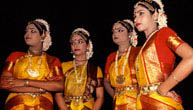 |
| Chakyarkoothu |
Chakyarkoothu, also called koothu, is one of the oldest classical theatre arts of Kerala. It is a solo dance is usually performed in the koothambalam of temples to the accompaniment of the mizhavu and elathalam. The performance starts with the invocation of the presiding deity of the temple. The narration of the story, generally picked from the Epics, is portrayed with the thandava dance movements, gestures and facial expression according to the guidelines given in the Natya Sastra. |
|
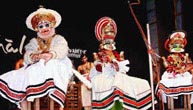 |
Koothu is marked for the presence of comic element, which adds to its dramatic character. The costume worn during the performance is colorful and unconventional with an unusual headgear. |
| Kathakali |
Kathakakli is the classical dance drama of Kerala based on the guidelines laid in the Natya Sastra. This elaborate art form is usually begins in the evenings and continues till dawn. It is an inherent part of all temple and cultural festivals in Kerala. The costumes and makeup are ornamental, colorful and elaborate so that the gestures and expressions of the performer are easily seen and understood. The performers do not speak or sing but enact the story through hand gestures, graceful body movements and facial expressions especially of the eyes. |
|
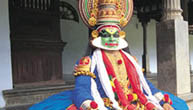 |
The themes of this dance form are from rich and vibrant mythology of Indian culture. Music is an essential feature of Kathakali and two vocalists are there who sing to the beats of a chengila (gong), elathalam (small cymbals), chenda and maddalam. |
| Mohiniyattam |
Mohiniyattam is a classical solo dance style, which is a blend of the grace and elegance of Bharata Natyam with the strength and force of Kathakali to build a mood of sringara or romance. The dance is usually performed on specially made stages during the temple festivals. The costume for the dance is the traditional white mundu and melmundu of Kerala and with the hairs gathered up at one side of the head and adorned with jasmine flowers in the traditional style. |
|
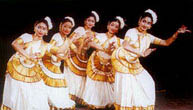 |
Koothu is marked for the presence of comic element, which adds to its dramatic character. The costume worn during the performance is colorful and unconventional with an unusual headgear. |
| Kalampattu |
Kalampattu or Kalamezhuthu Pattu is a folk art form that is practiced in the northern parts of Kerala. More than 600 years old art form, it is performed by a group of five to fifteen people in the Bhadrakali and Ayyappa temples. The ritual is performed around the Kolam, which is an elaborate picture usually of Bhadrakali drawn on the floor with the use five colors. The dance is performed in the light of temple torches continue all through the night. A series of songs or kalampattu are sung to the accompaniment of nanthuni and elathalams. |
|
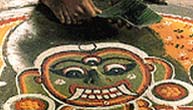 |
| Kaliyoottu |
Kaliyoottu is an eight daylong folk ritual, which depicts the combat between goddess Durga and the demon Darika. The ritual is performed at various stages and the climax of the play is called Paranettu. This ritual is performed on a specially constructed 100 feet high stage on the eighth day. |
| Kavadiyattam |
Kavadiyattam is a ritualistic dance form performed by a group of devotees wearing bright yellow or saffron costumes with ash smeared all over the body. The dance depicts Kavads carrying kavadis on their shoulders. The beats of instruments like udukku and chenda and the nadaswaram are integral part of the kavadi procession. It is usually performed in the Subramanya temples. |
|
|
| Kalaripayattu |
Kalaripayattu is the complete system of martial arts of Kerala. It is considered as one of the oldest and most scientific martial arts in the world. The training of Kalaripayattu aims at the perfect co-ordination of body and mind and the traditional training in a Kalari include specialization in the indigenous medical practices too. Kalaris are also centers of religious worship. |
|
|
| Velkali |
Velkali is one of the most detailed and dramatic martial folk arts of Kerala and is usually performed within the temple premises. It is called thirumumbil vela when performed before the deity and kulathilvela when performed near the temple pond. Fifty or more performers dressed in the traditional attire of soldiers, bearing colorful shields and swords or long canes, dance in war like rhythm in perfect beat of the thakil, suddha maddalam, elathalam, kuzhal and trumpets. A few fighting techniques of Kalaripayattu are also presented in the course of the performance. |
|
|
|
|
|
|
|
|
|
|
|
|
|
|
